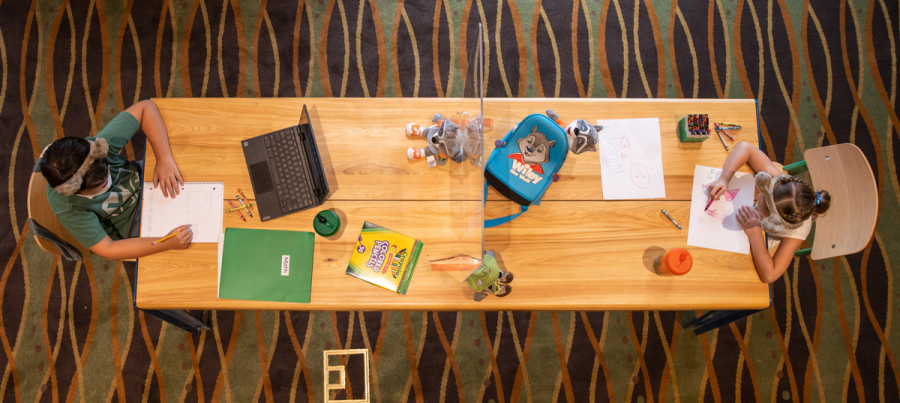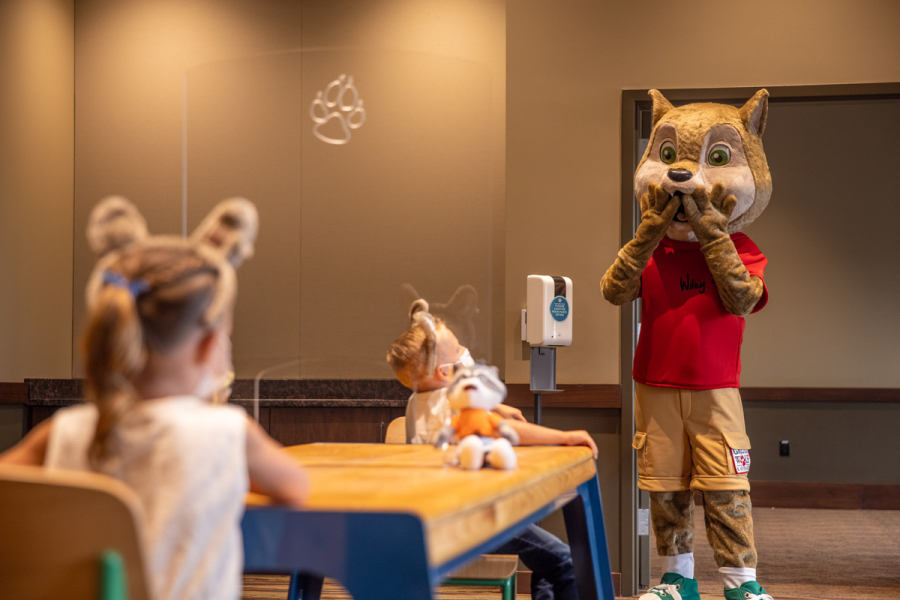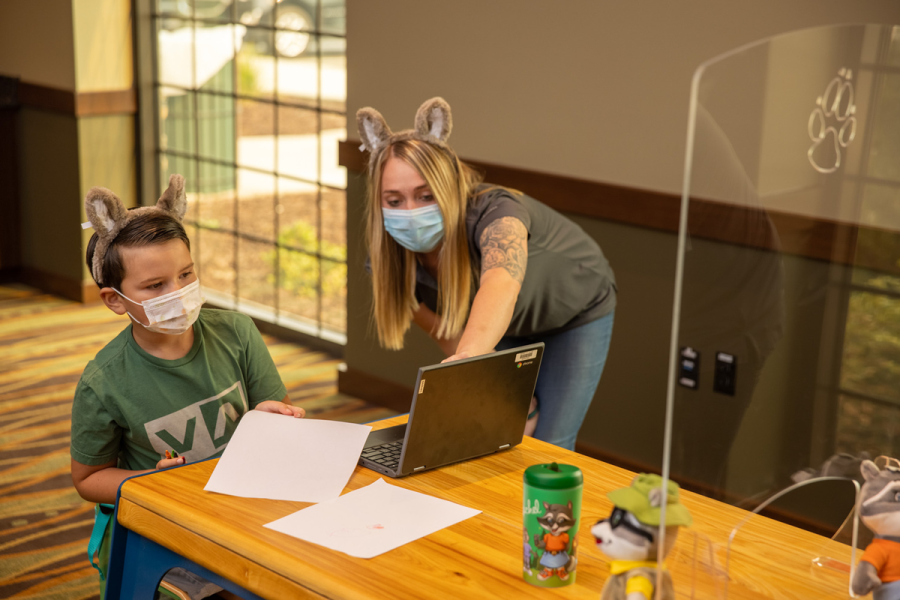Workcation Fixation

At Great Wolf Lodge in Scottsdale, Arizona, Wiley the Wolf leads a morning exercise routine for youngsters attending the resort’s “Howl ’N Learn” remote education program. About half a dozen primary and middle school students follow Wiley’s lead. While standing next to wooden tables that have been converted into desks, each child wears a mask and is separated from others in the room by a plexiglass barrier.
Following the morning stretch with Great Wolf Lodge’s mascot, the students pursue their own remote learning curricula, based on the programming and instructions of their teachers back at their home school. Great Wolf Lodge pack members are on hand to assist with elementary academic questions, as best they can, as well as technical issues like Wi-Fi connectivity. The staff has also planned hands-on activities, like crafts and coloring sheets, to engage the children when there are breaks in their online lessons.
By transforming meeting areas that have not been in high demand into classrooms, the “Howl ’N Learn” initiative is an efficient use of resort facilities for Great Wolf Lodge, which owns and operates 18 resorts for families with young children across North America. The program caters to primary and middle school students, and it also plays an important role for their parents.
“While the kids are addressing their e-learning in Wiley’s Schoolhouse, parents have three uninterrupted hours to focus on work or just relax and enjoy the resort,” explains Jason Lasecki, director of corporate communications at Great Wolf Resorts. Great Wolf Lodge has also set up pop-up business centers near the classrooms for parents who prefer an office environment.

From Crisis to Opportunity
Remote learning has placed a strain on many working parents, Lasecki notes, yet remote work—coupled with the cancellation of in-person education in many school districts—also provides families with the flexibility to travel at times of the year when they normally would not.
This newfound flexibility is giving a boost to other resorts as well.
“We’ve definitely seen an uptick in our cabins business,” says Brian Angello, director of hospitality marketing for The Dollywood Company. “Guests are sharing that they’re visiting because they’re wanting to get away in a place that’s nice, has great amenities, and can offer a place for them to socially distance.” Angello notes that visitors are staying longer as well, as they work and study from the cabins.
As attractions and resorts examine how to revamp their business models in the face of the COVID-19 pandemic, companies across the globe are finding opportunity in the realm of schoolcations and workcations. Four Seasons Resorts in Mexico and the Caribbean offer supervised school lessons, while hotels from Aruba to Vietnam promote work-from-hotel specials for day-trippers and longer stays alike.
A theme park in Tokyo, Yomiuri Land, has taken remote work to an even higher level, literally. For those who really enjoy an office with a view, they can work from Wi-Fi-enabled gondolas inside the park’s giant Ferris wheel. Yomiuri Land’s “amusement workcation” package also includes workspace by the pool and time on the driving range.
A Preference for the Countryside
For most Tokyoites, though, the concept of a workcation is not simply a day away from the home office. Rather, it is a trip to quieter part of the country, where they can spend a week or longer, away from the fast pace of the city, connecting with nature while still remaining connected to the office.
The Japanese government began encouraging domestic tourism through a national “Go To Travel” campaign that offers subsidies of up to 50%. Resorts, hotels, and Japan’s national carriers have capitalized on the $12 billion initiative to promote workcations.
Two examples include Tokyo’s Izu-Imaihama beach resort, on the south coast of the country, which “thoroughly welcomes initiatives in line with new lifestyles” and promises to be the perfect place for remote work and online lessons, and Nagano prefecture’s Nomad Work Center, whose homepage says that it is “an environment where you can work normally in the vast nature.”
“The ‘Go To Travel’ campaign has worked well to demonstrate that the industry is viable and people still want to travel,” says Drago Djourov, managing director of the hospitality research consultancy DD. “It’s good to see people flexing their travel muscle.”
Against the backdrop of the “Go To Travel” campaign, “the workcation has been a bit of an experiment,” he adds. “They never saw it as something they can scale much, but they saw it as an opportunity to help more remote destinations.”
Lessons Learned
Great Wolf Lodge launched the “Howl ’N Learn” program in five states: Arizona, Georgia, Illinois, Pennsylvania, and Texas. The concept proved best in locations where education is exclusively remote, as opposed to regions that have adopted a hybrid approach.
One of the biggest challenges to implementation is that students’ schedules are not synced; some schools start earlier than others. Great Wolf Lodge also quickly discovered that younger children, kindergarten and first-graders, need more supervision than older students. Fortunately, an advance booking system allows the resorts to staff the schoolhouses appropriately; no walk-ins are allowed.
“I think we found the right balance by keeping it extremely flexible in treating it more like a business center, where you knew that people were going to come and go at various times, but also making sure we kept it fun and light where there were plenty of things for the kids to do when they had some downtime,” says Lasecki.
The hotel’s existing communications infrastructure has served the program well. In-house technicians direct existing Wi-Fi into the classrooms to ensure there is sufficient bandwidth, while some minor purchases like plexiglass barriers were required at the debut. Desks are spaced 2 or 3 meters apart, students use sanitizer upon entry, and everyone wears masks in the room, in accordance with Great Wolf Lodge’s “Paw Pledge” to promote safe play.

Opportunities for the Future
In a normal year, 2.5 million students are home-schooled in the United States. Thanks to the pandemic, that number is estimated to have doubled in 2020. Many of these families will continue to home-school their children in the future, presenting resorts with post-pandemic, remote education opportunities.
Back in Japan, meanwhile, attractions may find new openings working with resorts and other destinations to offer workcations. To be successful, though, the key may lie in approaching potential corporate partners, rather than simply marketing to the public.
“People still feel like they need permission from the company to do these things,” Djourov says. “Partnering with companies will enable people to embrace it. There’s definitely a big opportunity to bring corporates on board as a way to help them offer benefits to their employees around wellness. Ultimately, workcations are not a mass product, but there will be repeaters. If people have a good experience, they will do it again.”
And that could be the surest solution to ensure that the workcation and schoolcation approach has legs and does not disappear once COVID-19 vaccinations are widely available.
Michael Switow is a Singapore-based writer who covers the Asia-Pacific attractions industry for Funworld.
